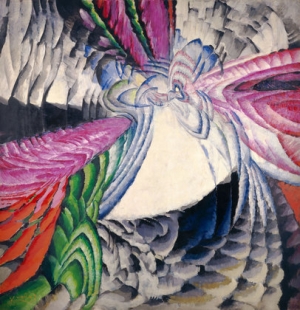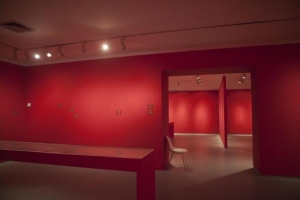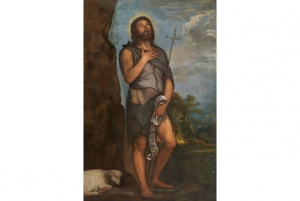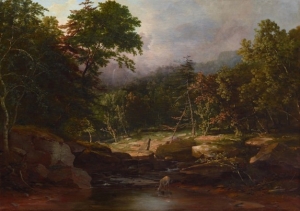|
Displaying items by tag: Curator

New York’s Metropolitan Museum of Art, the largest art museum in the United States, can be difficult to navigate in a short period time. With over two million works in its collection, visitors to the Met usually spend a few minutes with an object before moving on to one of the many masterpieces that awaits them. In an effort to highlight some of the museum’s not-to-be-missed objects, Met officials have launched the web series, 82nd & Fifth, aptly named after the museum’s Manhattan location.
The series presents 100 pieces from the Met’s vast collection in separate episodes. During each episode, a museum curator explains the work’s significance, not just to the art world and the museum, but also to them on a personal level.
The Met has already posted six 2-½ to 3-minute videos, which include interactive features, on the 82nd & Fifth web page. Highlighted works include a room with furnishings designed by Frank Lloyd Wright (1867-1959) between 1912 and 1915, a Renaissance relief sculpture by Antonio Rossellino (1427-circa 1478/1481), Giovanni Battista Tiepolo’s (1696-1770) massive painting The Triumph of Marius (1729), and an etching by Rembrandt (1606-1669) titled Christ Crucified Between Two Thieves: The Three Crosses (1653).
The Met will post two new videos on Wednesday morning of each week through December 25, 2013.

Inventing Abstraction, 1910-1925 opened on December 23 at the Museum of Modern Art in New York and celebrates the bold art movement that swept across mediums and continents during the first half of the twentieth century. Severing ties with the realistic, practical images that dominated western art, abstraction infiltrated everything from sculpture and painting to poetry, music, and film.
Inventing Abstraction brings together over 350 works including paintings, stained glass, needlepoint, film, sculpture, and illustrated books. Organized by Leah Dickerman, a curator in MoMA’s painting and sculpture department, and Masha Chlenova, a curatorial assistant, the show includes many pieces that are on loan from outside museums.
Inventing Abstraction features works by Marsden Hartley (1877-1943), Marcel Duchamp (1887-1968), Piet Mondrian (1872-1944), Wassily Kandinsky (1866-1944), and many others. While extremely comprehensive, the exhibition draws connections between artists and illustrates the development of abstraction over time.

On view through April 12, 2013 at the Cleveland Museum of Art, Picasso and the Mysteries of Life: Deconstructing La Vie is the first exhibition devoted to Pablo Picasso’s (1881-1973) complex masterpiece, which defined his well-known Blue Period. A cornerstone of the museum’s collection, La Vie (1903) is accompanied by related works on loan from Barcelona’s Museu Picasso as well as works by Francisco Goya (1746-1828), Albrecht Dürer (1471-1528), and Auguste Rodin (1840-1917) from the Cleveland Museum’s own collection.
The exhibition uses x-radiographs, infrared reflectographs, and other scientific methods to delve into the process behind La Vie. Displayed on iPads, the technological investigation illustrates Picasso’s creative process and how he altered the painting’s composition considerably before deeming the work complete.
Picasso drew preliminary sketches for La Vie in May of 1903. At the time, he was a young, unknown artist who still lived in his parents’ home in Barcelona. The first sketches depicted an artist in his studio and evolved into a more intricate scene meant to evoke thoughts about life and art and the intersection of the two. A solid analysis of La Vie has always eluded scholars due to its enigmatic subject, early history, and its relationship to Picasso’s other works from this time. However, the painting has never been examined as thoroughly and in-depth as by the Cleveland Museum of Art.
Picasso and the Mysteries of Life strives to make sense of the work by exploring the subjects of the painting. Carles Casagemas, the gaunt man featured in the work’s left foreground, was a friend of Picasso’s and a fellow artist. Casagemas committed suicide in 1901, prompting Picasso to contemplate the glorification of suicide and the bohemian lifestyle in modern art and culture. The woman standing behind Casagemas in La Vie has been identified as Germaine Pichot, his lover and a contributor to his suicide. Pichot stands as a symbol of Picasso’s coded representation of women and in a broader sense, as the fatal woman often portrayed in modern art.
A 163-page book by William H. Robinson, the Cleveland Museum’s curator of modern European art, accompanies the exhibition. The book further explores the role of La Vie in Picasso’s creative process as well as the important issues in the modernist culture of the 19th and 20th centuries that affected Picasso and his work. Robinson explores how Spanish and French literature affected Picasso’s Blue Period paintings, the impact of Rodin’s large retrospective of 1900 on the young artist, and Picasso’s ongoing struggle to fully understand the notions of fate and destiny.
Deconstructing La Vie is the inaugural exhibition in the Cleveland Museum of Art’s new Focus Gallery.

Members of the Los Angeles County of Museum of Art currently pay $400 a year for exclusive access at the institution. All of that is about to change as museum director, Michael Govan, announced that he will be raising annual fees for members to $1,000 a year. A $250-level museum membership must be purchased separately annually. The announcement has council members as well as art enthusiasts and professionals threatening to leave the institution.
While Govan stands behind his decision, some feel he is jeopardizing the support of smaller donors and will scare off younger people from becoming members. At a meeting for council members on Tuesday, November 27, Govan explained his decision, stating that the changes are part of a larger restructuring plan to simplify the museum’s system and make it more professional. Govan also plans to dismantle each of the ten museum council boards, leaving only a chairperson to assist the department curator and development staff.
The fee increase will go into effect in January for new members and in June for existing ones.

While rocket fire is a normal occurrence in southern Israel, the recent attacks on Tel Aviv, the country’s northern capital city, has art museums in the area taking extra precautions. The walls of the Tel Aviv Museum of Art have been stripped and nearly 200 works, including approximately 100 works by relatives of the Renaissance master Pieter Brueghel the Elder, were moved to a rocket-proof safe late last week.
While the Israeli-Palestinian conflict has continued to escalate, other museums are following suit. The curator of the Ashdod Art Museum in southern Israel has taken down 15 works by the leading Contemporary Israeli artist, Tsibi Geva, and placed them in a vault deep underground. The structure is designed to withstand both rocket fire and biological weapons. It was the first time the Ashdod Museum has taken down any art amid attacks since opening in 2003.
While air strikes are creeping up from the southern Israel’s traditional rocket range to Jerusalem and Tel Aviv, some institutions are holding out on stashing their works. The Eretz Israel Museum in Tel Aviv, which specializes in Near Eastern antiquities and other art, has left its treasures in place. The Israel Museum in Jerusalem, which houses some of the country’s most prized antiquities and cultural artifacts has also continued to operate as usual.
The last time the Tel Aviv Museum of Art took down works during a conflict was in 1991 when Iraqi scud missiles pounded the city during the Gulf War.

Titian’s Saint John the Baptist entered Madrid’s Museo del Prado’s collection in 1872 but rather than being credited to the Italian painter of the 16th century, it was said to be by an anonymous Madrid School artist of the 17th century. Fourteen years later, the painting was sent to the parish church of Nuestra Senora del Carmen in Cantoria in the province of Almeria where it remained on loan until 2007.
The Prado held an exhibition of Titian’s work in 2003 and published an accompanying catalogue in which Miguel Falomir, Head of the Department of Italian and French Paintings at the Museum and the exhibition’s curator, suggested that the painting in Cantoria was a copy of a long-lost Titian painting. In 2007 the Museum embarked on a study of the work only to find that the piece was not a copy but an original Titian painting. The work’s preparatory layer of white lead and calcium carbonate and the similarities between that painting and two other depictions of Saint John the Baptist done by the artist in the early 1550s helped researchers to date the painting and bolstered their decision to re-attribute the work to Titian.
The work arrived at the Prado in poor condition and underwent thorough restoration by Clara Quintanilla. The will be on display alongside the two other versions until February 10, 2013.

David Hickey, one of America’s foremost art critics is known for his acerbic commentary, but his latest tirade against the world of modern art is downright scathing. Hickey, a professor, curator, and author, told the Observer that he will be walking away from contemporary art, a genre he says has been ruined by rich collectors who are more concerned with money and celebrity than quality.
Hickey claims that art editors and critics have lost their edge, spending more time catering to the wealthy people who hold the reigns on the contemporary art market than surveying the actual work (which he says is also lacking). Hickey is not alone in this claim. A number of contemporary art curators, museums, and galleries have deemed the work of such artists as Damien Hirst, Tracey Emin, and Antony Gormley bloated and empty – the result of too much fame and not enough criticism. While the notion of the artist as celebrity is not new, today’s market is saturated with it and gaining status has taken precedence over making revolutionary, ground-breaking art.
A former dealer, Hickey is attuned to considering art in monetary terms but his objections stem from his belief that contemporary art has become too broad, too elitist, and lacks discretion. Hickey’s retirement will remove an important critical voice from the equation. He plans to complete a book on the pagan roots of America, aptly titled Pagan America, as well as a book of essays titled Pirates and Framers.

The publisher and art critic, Christian Zervos, founded the French art review, Cahiers d’Art, in 1926. The magazine ran without interruption from 1941 to 1943, until 1960 and featured artists such as Picasso, Matisse, Braque, Leger, Ernst, Calder, and Giacometti. Known for its striking layout and abundant photography, Cahiers d’Art also featured reviews written by the likes of Ernest Hemingway and Samuel Beckett. After being out of production for more than fifty years, Cahiers d’Art has been reborn.
Swedish collector and entrepreneur, Staffan Ahrenberg, bought the dormant publication after he walked by the still-operating Cahier d’Art gallery along the rue du Dragon in Paris. Ahrenberg re-launched Cahiers d’Art with former Art Basel director Sam Keller and the renowned curator Hans Ulrich Obrist as editors. The first issue features Ellsworth Kelly, Cyprien Gaillard, and Sarah Morris. As in the past, Cahiers d’Art will not contain advertisements nor will it follow a regular production schedule.
Major art world players including Larry Gagosian, Guggenheim boss Richard Armstrong, and Alfred Pacquement of the Pompidou Centre gathered in a tiny Left Bank gallery in Paris to celebrate the review’s return.

A curator at the Dallas Museum of Art discovered an unsigned painting likely created by the American landscape painter, George Inness. The work has been in the museum’s collection for more than 80 years but had been attributed to Asher B. Durand, one of the leading figures of the Hudson River School painters. The mid-19th century art movement had a profound influence on Inness’ work.
After experts at the museum questioned In the Woods’ attribution, American art curator Sue Canterbury decided to do some research on the oil on canvas. Canterbury explored other artists whose work fit with In the Woods’ aesthetic and stumbled upon Michael Quick’s George Inness: A Catalogue Raisonne. Within the raisonne Canterbury found a pen and ink drawing that bore a striking resemblance to In the Woods. It was then that the museum decided to reattribute the painting to Inness.
The bucolic forest scene has been renamed Stream in the Mountains by curators and will be display at the museum. It is a significant work because it is from Inness’ early years and not many of his works from this era have survived.

When Timothy J. Standring, curator of painting and sculpture at the Denver Art Museum, suggested an exhibition of Vincent van Gogh’s work, it was quite a risk, mainly because the museum doesn’t own a single work by van Gogh. In addition, the Denver Art Museum’s strength lies in American Indian, pre-Columbian, and Spanish Colonial Art – not ideal holdings when attempting to swap works with European painting departments.
On October 21, six years after the thought first popped into Standring’s head, Becoming van Gogh will open to the public at the Denver Museum. The show will be comprised of 68 paintings and drawings by van Gogh and about another 20 works by artists he studied under.
A true labor of love, Standring traveled to 39 cities in Europe, at least 30 in North America, and another two in South America to do research, meet with scholars, view works, and negotiate with owners. Co-curated by Louis van Tilborgh, the exhibition evolved as the duo delved deeper into their research. Inspired by James Shapiro’s A Year in the Life of William Shakespeare: 1599, Standring wanted to capture the period when van Gogh became van Gogh. At first he thought a show of 30 oils and drawings done between 1887 and 1888 would be sufficient, but as his research progressed, Standring decided to explore van Gogh’s work from 1886–1888, the artist’s years in Paris.
Standring proceeded to make a checklist of all the works he wished to acquire. He made connections with curators at other museums, phoned friends and collectors. As he continued, the need for more works became apparent. Standring wanted to include early works from van Gogh’s time in the Netherlands and his later years in Provence. After countless phone calls, letters, negotiations, meetings, and planning, the exhibition came to fruition. Becoming van Gogh will be on view through January 20, 2013.
|
|
|
|
|